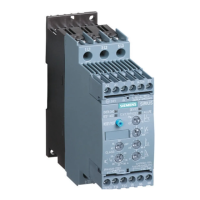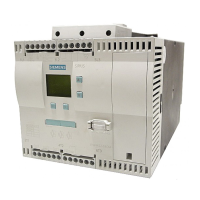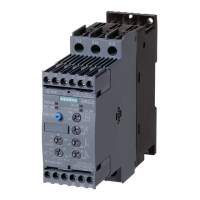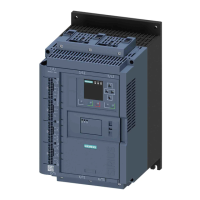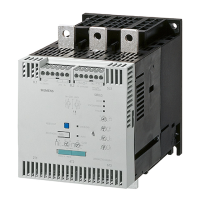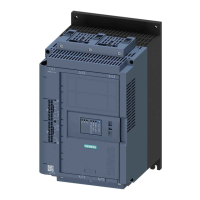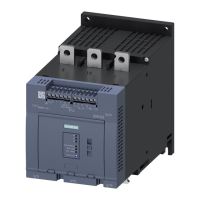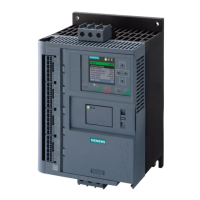Do you have a question about the Siemens SIRIUS 3RW44 and is the answer not in the manual?
Device use and commissioning by qualified personnel only.
Device use according to catalog/technical description and approved components.
Lists registered and non-registered trademarks of Siemens AG.
Outlines manual's purpose: basics and tips on SIRIUS 3RW44 soft starters.
Manual aimed at users commissioning, servicing, and planning systems.
Soft starter complies with IEC/EN 60947-4-2 standard.
Explains motor principles and soft starter operation.
Details applications and selection criteria for soft starters.
Specifies environmental limits for storage and operation.
Covers general configuration aspects, PC interface, and software tools.
Discusses application examples for different starting classes (CLASS 10, 20, 30).
Explains on-time calculation and switching frequency limits.
Details effects of altitude and temperature on device performance and derating.
Information on resetting the soft starter to default factory settings.
Explains how to interpret the order number for 3RW44 soft starters.
Covers unpacking, mounting position, and standards compliance.
Discusses general motor branch structure, disconnector, and switching element.
Explains necessary protection measures, including semiconductor fuses.
Guidelines on connecting capacitors for power factor improvement.
Details suitability and considerations for generator operation.
Describes control/auxiliary and main current connections.
Explains the graphic display and the four control keys for operation.
Details local interface, optional PROFIBUS, and external display/control unit.
Describes connection and functionality of the optional external unit.
Explains menu navigation and how to change parameters.
Covers initial device startup and commissioning procedure.
Details how to set parameters beyond quick start or factory defaults.
Guides through setting parameters for motor data, starting, and stopping.
Covers additional functions like measured value display and statistics.
Explains the use of three adjustable parameter sets for different applications.
Details various starting modes like Voltage Ramp and Torque Control.
Explains different stopping modes like Coasting Down, Torque Control, and DC Braking.
Describes operating the motor at reduced speed.
Explains setting min/max current limits for load monitoring.
Covers overload protection, tripping classes, and temperature monitoring.
Explains built-in device protection for thyristors.
Overview of diagnostic functions and message types.
Lists and explains various device error codes and their remedies.
Introduces the PROFIBUS DP module and its integration.
Explains data transmission options and communication principles.
Step-by-step guide for installing the module.
Covers activation and address setting via display or software.
Details configuration using GSD files or Soft Starter ES software.
Provides an example of commissioning using STEP 7.
Explains process data and image structures for PROFIBUS communication.
Describes how to interpret diagnostic information from LEDs.
Explains how to read diagnosis information using STEP 7.
Provides various wiring diagrams for main and control circuits.
Provides an overview of the device's menu structure and parameters.
Specifies permissible conditions for transport and storage.
Comprehensive technical specifications for power and control units.
Details motor protection tripping characteristics with and without asymmetry.
Provides mechanical dimensions and mounting details for soft starters.
Device use and commissioning by qualified personnel only.
Device use according to catalog/technical description and approved components.
Lists registered and non-registered trademarks of Siemens AG.
Outlines manual's purpose: basics and tips on SIRIUS 3RW44 soft starters.
Manual aimed at users commissioning, servicing, and planning systems.
Soft starter complies with IEC/EN 60947-4-2 standard.
Explains motor principles and soft starter operation.
Details applications and selection criteria for soft starters.
Specifies environmental limits for storage and operation.
Covers general configuration aspects, PC interface, and software tools.
Discusses application examples for different starting classes (CLASS 10, 20, 30).
Explains on-time calculation and switching frequency limits.
Details effects of altitude and temperature on device performance and derating.
Information on resetting the soft starter to default factory settings.
Explains how to interpret the order number for 3RW44 soft starters.
Covers unpacking, mounting position, and standards compliance.
Discusses general motor branch structure, disconnector, and switching element.
Explains necessary protection measures, including semiconductor fuses.
Guidelines on connecting capacitors for power factor improvement.
Details suitability and considerations for generator operation.
Describes control/auxiliary and main current connections.
Explains the graphic display and the four control keys for operation.
Details local interface, optional PROFIBUS, and external display/control unit.
Describes connection and functionality of the optional external unit.
Explains menu navigation and how to change parameters.
Covers initial device startup and commissioning procedure.
Details how to set parameters beyond quick start or factory defaults.
Guides through setting parameters for motor data, starting, and stopping.
Covers additional functions like measured value display and statistics.
Explains the use of three adjustable parameter sets for different applications.
Details various starting modes like Voltage Ramp and Torque Control.
Explains different stopping modes like Coasting Down, Torque Control, and DC Braking.
Describes operating the motor at reduced speed.
Explains setting min/max current limits for load monitoring.
Covers overload protection, tripping classes, and temperature monitoring.
Explains built-in device protection for thyristors.
Overview of diagnostic functions and message types.
Lists and explains various device error codes and their remedies.
Introduces the PROFIBUS DP module and its integration.
Explains data transmission options and communication principles.
Step-by-step guide for installing the module.
Covers activation and address setting via display or software.
Details configuration using GSD files or Soft Starter ES software.
Provides an example of commissioning using STEP 7.
Explains process data and image structures for PROFIBUS communication.
Describes how to interpret diagnostic information from LEDs.
Explains how to read diagnosis information using STEP 7.
Provides various wiring diagrams for main and control circuits.
Provides an overview of the device's menu structure and parameters.
Specifies permissible conditions for transport and storage.
Comprehensive technical specifications for power and control units.
Details motor protection tripping characteristics with and without asymmetry.
Provides mechanical dimensions and mounting details for soft starters.
| Product Category | Soft Starter |
|---|---|
| Number of Poles | 3 |
| Rated Operational Voltage Ue | 200 ... 690 V |
| Voltage Range | 200 ... 690 V |
| Approvals | UL |
| Communication | Optional |
| Communication Interface | PROFIBUS DP, Modbus RTU |
| Functions | Soft start, Soft stop, Pump control, Torque control |
| Mounting Type | Screw fixing |
| Ambient Temperature Range | -25 ... +60 °C |

